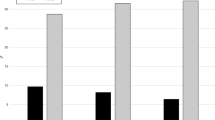Abstract
A culturally diverse sample of 4375 adolescents completed a self-report inventory assessing their current amount of smoking, and several psychosocial predictors of smoking (e.g., depression, anger, stress, smoking among peers, etc). Results revealed that Whites smoke more than Blacks, Asians, and less acculturated Latinos but not more than highly acculturated Latinos. Stepwise regression analyses of the predictors of smoking found significant ethnic and acculturation differences in the relative predictive power of 18 well-known risk factors. Smoking among peers was the best predictor of smoking for White adolescents (accounting for 23.5% of the variance) but accounted for only 15% of the variance for Latino youth, 9.6% of the variance for Asian youth, and none of the variance for Black youth. Results are discussed in terms of their implications for smoking prevention programs that focus on resisting peer influences.
Similar content being viewed by others
References
Akers, R. L., Krohn, M. D., Lanza-Kaduce, L., and Radosevich, M. (1979). Social learning and deviant behavior.Am. Sociol. Rev. 44: 636–655.
Botvin, G., and Eng, A. (1980). A comprehensive school-based smoking prevention program.J. School Health 11: 209–213.
Castro, F. G., Maddahian, E., Newcomb, M. D., and Bentler, P. M. (1987). A multivariate model of the determinants of cigarette smoking among adolescents.J. Health Soc. Behav. 28: 273–289.
Dusenbury, L. Kerner, J. F., Baker, E., Botvin, G., James-Ortiz, S., and Zauber, A. (1992). Predictors of smoking prevalence among New York Latino youth.Am. J. Public Health 82: 55–58.
Farrell, A. D., and Danish, S. J. (1993). Peer drug associations and emotional restraint: Causes or consequences of adolescents' drug use?J. Consult. Clin. Psychol. 61(2): 327–334.
Farrell, A. D., Danish, S. J., and Howard, C. W. (1992) Relationship between drug use and other problem behaviors in urban adolescents.J. Consult. Clin. Psychol. 60(5): 705–712.
Flay, B. R. (1985). Psychosocial approaches to smoking prevention: A review of findings.Health Psychol. 4: 449–488.
Flay, B. R., Brannon, B. R., Johnson, C. A., et al. (1988). The television, school, and family prevention/cessation project, I.Prev. Med. 17: 585–607.
Haynes, S. G., Harvey, C., Montes, H., Nickens, H., and Coehn, B. H. (1990). Patterns of cigarette smoking among Latinos in the United States: Results from HHANES 1982–1984.Am. J. Public Health 80 (Suppl): 47–54.
Headen, S. W., Bauman, K. E., Deane, G. D., and Koch, G. G. (1991). Are the correlates of cigarette smoking initiation different for Black and White adolescents?Am J. Public Health 81: 854–858.
Hurd, P. D., Johnson, C. a., Pechacek, T., Bust, L. P., Jacobs, D. R., and Leupker, R. V. (1980). Prevention of cigarette smoking in 7th grade students.J. Behav. Med. 3: 15–28.
Jessor, R., and Jessor, S. L. (1977).Problem Behavior and Psychosocial Development: A Longitudinal Study of Youth, Academic Press, San Diego, CA.
Kandel, D. B. (1980). Drug and drinking behavior among youth.Annu. Rev. Sociol. 6: 235–285.
Kandel, D. B. (1985). On the processes of peer influence in adolescent drug use: A developmental perspective.Adv. Alcohol Subst. Abuse 4: 139–163.
Kovacs, M., and Beck, A. T. (1977). An empirical-clinical approach toward definition of childhood depression. In Schulterbrandt, J. G., and Raskin, A. (eds.),Depression in Childhood, Raven Press, New York, pp. 1–25.
Leventhal, H., and Cleary, P. D. (1980). The smoking problem: A review of the research and theory in behavior risk modification.Psychol. Bull. 88: 370–405.
Leventhal, H., Fleming, R., and Glynn, K. (1988). A cognitive-developmental approach to smoking prevention. Maes, S. (ed.),Proceedings of the First Annual Expert Conference in Health Psychology, John Wiley, New York, pp. 79–105.
Newcomb, M. D., and Bentler, P. M. (1986). Substance use and ethnicity: Differential impact of peer and adult models.J. Psychol. 120(1): 83–95.
Oetting, E. R., and Beauvais, F. (1986). Peer cluster theory: Drugs and the adolescent.J. Counsel. Dev. 65: 17–22.
Oetting, E. R., and Beauvais, F. (1987). Common elements in youth drug abuse: Peer clusters and other psychosocial factors.J. Drug Issues 2: 133–151.
Presson, C. C., Chassin, L., Sherman, S. J., Olshavsky, R., Bensenberg, M., and Corty, E. (1984). Predictors of adolescents' intentions to smoke: Age, sex, race and regional differences.Int. J. Addict. 19(5): 503–519.
Richardson, J. L., Dywer, K., McGuigan, K., Hansen, W., Dent, C., Johnson, C. A., et al. (1989). Substance use among 8th grade students who take care of themselves after school.Pediatrics 84(3): 556–566.
Santiseban, D., and Szapocnik, J. (1982). Substance abuse disorders among Hispanics. In Beccerra, R. M., Karno, M., and Escobar, J. I. (eds.),Mental Health and Hispanic Americans, Grune & Stratton, New York, pp. 83–100.
Sussman, S., Dent, C. W., Flay, B. R., Hansen, W. B., and Johnson, C. A. (1987). Psychosocial predictors of cigarette smoking onset by White, Black, Hispanic, and Asian adolescents in Southern California.Morbid. Mortal. Week. Rep. (Suppl). 36: 11S-16S.
Swaim, R. C., Oetting, E. R., Edwards, R. W., and Beauvais, F. (1989). Links from emotional distress to adolescent drug use: A path model.J. Consult. Clin. Psychol. 57: 227–231.
Vega, W. A., Zimmerman, R. S., Warheit, G. J., Apospori, E., and Gil, A. G. (1993). Risk factors for early adolescent drug use in four ethnic and racial groups.Am. J. Public Health 83: 185–189.
Author information
Authors and Affiliations
Additional information
This research was supported by NIDA Grant R01DA6307 to Brian Flay.
Rights and permissions
About this article
Cite this article
Landrine, H., Richardson, J.L., Klonoff, E.A. et al. Cultural diversity in the predictors of adolescent cigarette smoking: The relative influence of peers. J Behav Med 17, 331–346 (1994). https://doi.org/10.1007/BF01857956
Issue Date:
DOI: https://doi.org/10.1007/BF01857956



